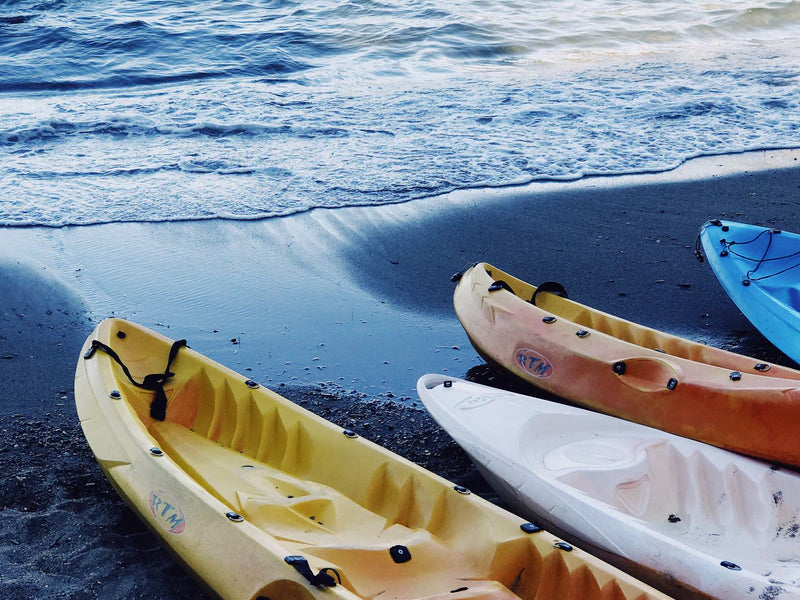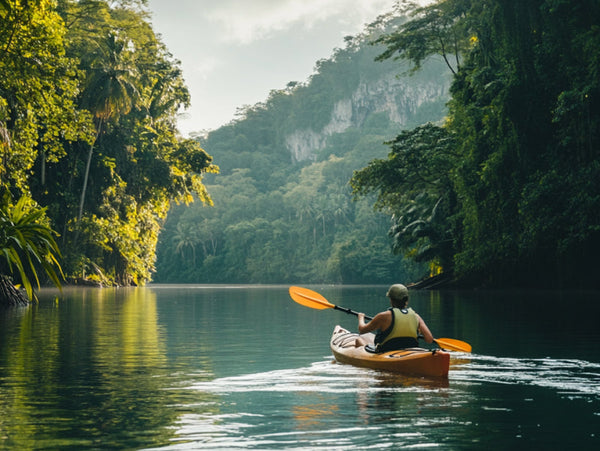Top Kayak Storage Solutions of 2020

After a long day on the water, it’s best to have a safe place to store your kayak. When shopping for a kayak storage solution, you’ll want to look for something that’s stable, secure, durable and easily accessible. Depending on your needs, budget and available space, there are six main types of storage options to choose from: straps/pulleys, wall racks, freestanding racks, ceiling racks, folding stands and the DIY racks. Below we’ll dive in a little deeper and explain the pros and cons of each.
Straps and Pulleys
These types of storage options are perfect for those with minimal space. They’re lightweight, less bulky than traditional racks and they can easily be attached to a ceiling or wall.
Storage straps are simple straps that hang from the wall and wrap around your kayak. They’re fairly simple to install and can hold between 1 and 3 kayaks depending on the brand you purchase.
An example of this type of storage option is the Pelican Double Kayak Storage Strap System.
Pulleys and hoists are similar to storage straps whereas they wrap around your kayak, but unlike the wall straps, pulley and hoists connect to the ceiling. You lower the hoist to wrap the straps around your kayak, and then you lift the kayak to the ceiling using a pulley.
This type of storage requires a little bit more setup, but it frees up a bunch of space assuming you have higher ceilings. Because your kayak will be hanging from above, they don’t work as well with lower ceilings.
An example of this type of storage option is the RAD Sportz Kayak Hoist Lift.
Wall Racks
This is probably the most common type of kayak storage option. They come in different shapes, sizes and materials, but they all work the same whereas you screw the racks into the wall and you rest your kayak inside the cradles.
Examples of inexpensive wall racks are the RAD Sportz Kayak Wall Hangers.
They’re a little on the flimsy side, but if your kayak is lightweight and you’re looking to save a few dollars, these racks could be a good option.
If you’re looking for stronger, more durable wall racks, we suggest our own BEST Marine & Outdoors Wall Racks. Our wall hangers are made of heavy duty powder coated steel, nylon covered foam padding and adjustable straps that keep your kayak securely in place. You will pay a little bit more for our racks, but if quality is your thing, you’ll get what you pay for.
Freestanding Racks
These types of racks are very similar to wall racks, but rather than being bolted to a wall, they’re connected to their own freestanding units. These racks are great for those who would like the option of moving your racks around to different locations.
An example of a freestanding unit is our own BEST Marine & Outdoors Freestanding Racks. Each purchase includes two freestanding towers and two sets of kayak cradles (each with a 100lb weight capacity). Assembly is required, but between the instruction manual and our YouTube video, you’ll have them put together in no time.
Ceiling Racks
This type of storage option is a cross between wall racks and a kayak hoist. They’re similar to a kayak hoist because your kayak is stored at the ceiling, but they’re also like wall racks because they’re bolted in place.
Although safe and strong, these types of racks are not made for the weak, as they require you to physically lift your kayak into place. If you have high ceilings and you're physically strong, then this might be a great option for you.
An example of this type of storage option is the StoreYourBoard Kayak Ceiling Rack.
Folding Kayak Stands
This type of storage option is completely different from the rest. They’re small, lightweight and 100% portable. You can use them in your garage, shed or even bring them camping with you. Simply fold open the two stands and place your kayak on top.
An example of this type of storage option is the BEST Marine & Outdoors Folding Kayak Stands. The stands are 16” tall, they fold up small for easy storage and have a 100lb weight capacity. If versatility is your thing, a pair of folding kayak stands might be perfect for you.
Build Your Own
If you’re handy, you could always build your own! There’s a bunch of YouTube videos out there showing you how to build your own kayak storage racks. It will require some lumber, bolts and expertise, but there’s something very satisfying about building and accomplishing a homemade project.
Well there you have it, six different options for storing your kayaks. Do you have any other ideas? If so, we’d love to hear them in the comments below. In the meantime, paddle on!
Disclosure: BEST Marine and Outdoors is a participant in the Amazon Services LLC Associates Program, an affiliate advertising program designed to provide a means for sites to earn advertising fees by advertising and linking to Amazon.com. This means if you click on the links above and purchase an item, we will receive an affiliate commission at no extra cost to you.
Leave a comment
Comments will be approved before showing up.
Also in Blog

How to Choose the Right Kayak Anchor
Choosing the right kayak anchor can make all the difference when it comes to staying steady on the water. This guide walks you through everything you need to know about selecting the perfect folding kayak anchor

What To Do When Your Kayak Capsizes
Although kayaks are designed for stability no matter the conditions, accidents happen and knowing what to do can help you avoid an unpleasant experience. Preparedness and technique are key components to controlling a sometimes scary situation.









